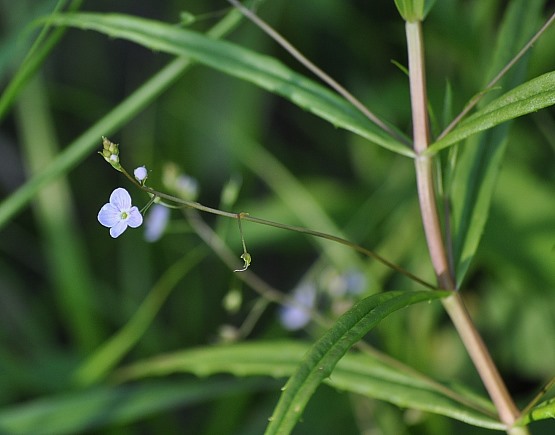Description: This herbaceous perennial wildflower is 8-24" tall and either unbranched or sparingly branched. The stems are erect, ascending, or sprawling; they are terete to slightly angular, light green to pale gray-red, and usually hairless. Pairs of opposite leaves about 1-3" long and 1/8–3/8" (3-10 mm.) across occur at intervals along the stems. These leaves are linear to linear-lanceolate, smooth or remotely toothed along their margins, and usually hairless; they clasp the stems. The upper surface of each leaf is hairless, medium green, and sometimes tinted purple.

Ascending to
widely spreading racemes of 8-20 flowers develop from the axils of the
middle to upper leaves; sometimes a single leaf in a pair of these
leaves will fail to develop a raceme, forming a secondary leafy shoot
instead. At maturity, these racemes are as long or longer than the
leaves. The central stem and pedicels of each raceme are light green,
slender, terete, and hairless (or nearly so). The pedicels are ½–¾"
long. At the base of each pedicel, there is a linear leafy bract that
is shorter than the pedicel. The flowers are ¼" across or a little
wider, consisting of a pale blue or white corolla with 4 petal-like
lobes, a short light green calyx with 4 lanceolate teeth, 2 stamens,
and a pistil with a single style. Fine blue lines radiate from the
throat of each corolla. The blooming period occurs from late spring to
to early fall, lasting several months. For each plant, only a few
flowers are in bloom at the same time. The flowers are replaced by seed
capsules about ¼" across that are heart-shaped and flattened; they are
slightly more wide than tall. Each seed capsule has 2 cells; each cell
has several tiny seeds. The root system is rhizomatous or
stoloniferous, forming vegetative offsets.
Cultivation:
The preference is full sun to light shade, wet to moist conditions, and
soil with some organic matter to retain moisture. Temporary flooding is
readily tolerated. This boreal species prefers cool moist weather.
Range & Habitat:
The native Marsh Speedwell is uncommon and state-listed as
'threatened.' It has
been found in only a few counties in central and NE Illinois. Illinois
lies along the southern range-limit for this species. In addition to
North America, it also occurs in Eurasia. Habitats include marshes, wet
meadows, low areas along springs, low muddy areas along ponds, and
swamps.
Faunal Associations:
Very little is known about floral-faunal relationships for this and
other Veronica spp. The flowers are visited by small
bees and flies, which seek primarily nectar. The caterpillars of the
butterfly Junonia coenia (Buckeye) feed on the
foliage of Veronica spp. The foliage is not known
to be toxic to mammalian herbivores or geese, and it may be eaten
occasionally by them.
Photographic Location:
The photograph was taken at a nature preserve in Cook County, Illinois,
by Lisa Culp (Copyright © 2009).
Comments:
Other common names of Veronica scutellata are
Skullcap Speedwell and Narrow-Leaved Speedwell. This delicate
wildflower is somewhat similar to Water Speedwell (Veronica
anagallis-aquatica) and American Brooklime (Veronica americana); these
species occupy similar wetland habitats and bloom at about the same
time of year. Marsh Speedwell differs from the latter two species by
its narrow leaves (less than ½" across). These native species should
not be confused with introduced Veronica spp. that
are weedy annuals. Species in this latter group prefer drier disturbed
areas and they tend to be smaller in size with much shorter leaves.